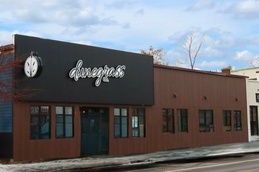Pirates of the Great Lakes
Sept. 15, 2013

Recalling the bucanneers of the 1800s
Pirates, pirates, pirates - they seem to be everywhere these days. From Johnny Depp’s wildly popular characterization of Captain Jack Sparrow in the Pirates of the Caribbean movies to the upcoming Tom Hanks movie Captain Phillips, in which Hanks’ character, based on real-life events, deals with the Somali pirates who hijack his cargo ship in the Indian Ocean. From Sid Meier’s computer-roleplaying game Pirates! to the animated feature The Pirates! Band of Misfits starring the voices of Hugh Grant and Jeremy Piven.
And you can even "˜celebrate’ pirates this September 19, which nerd-cred confirms is the official International Talk Like a Pirate Day - but you’d best go online to brush up on your pirate-speak, else you might get sent to walk the plank for your landlubber accent. Yarr!
One place you might not expect pirates, though, are in the Great Lakes - but avast, ye mateys, and pay attention, for pirates there were, indeed.

WHAT PIRATES?
Great Lakes pirates, who generally stalked the lakes during the mid 1800s into the early 1900s, may not have sought gemstones or treasure chests as their bounty, but they definitely had their own goals - if less glamorous ones.
Put aside that mental image of Jack festooned in jeweled chains and holding a golden goblet. Lumber, illegal alcohol, and venison were the goods that the Great Lakes pirates had their patched eyes on.
"Everyone seems to be fascinated with pirates," agrees Unsalted Sailing’s Rod Call, who hosts Great Lakes sailing events out of Traverse City. "Having sailed numerous times in the Caribbean, I’ve also become fascinated with the history and lore of Caribbean piracy. And of course Hollywood and Disney have managed to romanticize pirates, when in reality it was a ruthless and brutal way of life."
Call dug around to find out more about the Great Lakes pirates history, and has folded his interest into his local Unsalted Sailing brand with an amusing Up North pirates t-shirt design.
"The shirt design was inspired by the fact that the Great Lakes pirates stole venison," he explains. "Rather than the normal Jolly Roger (skull and crossbones), I wanted to create something unique to the Great Lakes, that had a story behind it."
As Call mentioned, the Hollywood version of pirates is what most people think of when the word "pirate" is bandied about. While plenty of people are intrigued by pirates, many don’t even know that Great Lakes pirates even existed.
"I think we tend to think of the 17th and 18th-century Caribbean pirates as the "˜real’ pirates," explains Bob Desh, executive director and curator of the three Door County Maritime Museums in Wisconsin. "There is a dearth of understanding about how important all maritime history is, including during the time of the pirates on the lakes - many of the things that happened on the East and West Coasts of the U.S. happened here, as well."
CALICO JACK
Desh, who is currently overseeing a Great Lakes Pirates exhibition at the museum’s Gills Rock, WI location, confirms that Great Lakes pirates definitely defied the "˜norm’ as far as what pirates are expected to be. "Quirky" might be the best word to describe them.
Timber pirates, as they were called, would cut down wide swaths of trees in the Upper Peninsula, then sell the timber out East.
"The East Coast was being deforested due to progress and building, so all of a sudden, lumber was a hot commodity," Desh explains. "The pirates at that time were a combo of lumberjack and seafaring pirate. They’d illegally clear-cut lands in the U.P. - private, government, didn’t matter - and would quickly transport the lumber to Chicago, Cleveland, Buffalo, and the rest of the East Coast."
Swashbuckling alcohol-runners would steal alcohol and sell it in Chicago or Detroit, sometimes exchanging the alcohol for firearms that they would then sell up in Canada.
Yet another well-known pirate was a little less ambitious.
"Calico Jack Rackham was more of a small time pirate from the 1800s," Desh laughs, "he became famous for stealing everything from fishing tackle right up to entire boats. Picture this: you’re a commercial fisherman, up in the wilds of the Upper Peninsula. You go out to your ship in the morning - and it’s gone. That was Calico Jack."
But perhaps the most notorious Great Lakes pirate was Roaring Dan Seavey, who started as a regular sailor in the U.S. Navy. After leaving the military, he tried but failed to get his share of the Klondike Gold Rush, and as the century turned he found himself a poor man with only the schooner Wanderer to his name.
SCUTTLED SEAVEY
Seavey could have perhaps turned things around for himself via legitimate shipping or transport. But instead, he turned pirate, thieving cargo, including large shipments of venison and alcohol, from other ships to resell at a higher price. The few who tried to stop him got the business end of the cannon that he carried on board.
He also ambushed other ships - pirate or not - by doing something called "moon cussing," altering or moving navigation lights in the Great Lake waters. Once a ship read the lights incorrectly, went the wrong way, and got into trouble, often winding up on the rocks, Seavey would swoop in and steal their cargo, as well.
His most famous exploit was his takeover of a schooner docked in Charlevoix, the Nellie Johnson. Seavey pulled a real Jack Sparrow for that one, inviting the crew to drink with him, staying mostly sober himself. He then threw the drunken sailors out of their ship and sailed it by himself to Chicago, where he sold the Nellie Johnson’s cargo.
A chase eventually ensued, as the law had discovered Seavey’s trick; he tried moon cussing the chase ship and remarkably succeeded, running it aground. But in his glee, he lost control of his own ship, and once a shot from the revenue cutter Tuscarora was fired across his bow, he reportedly crashed the boat and was finally captured, effectively ending his career as a pirate.
It wouldn’t be long before the rest of the pirate trade was to fade into history, as well.
"I think the rise of the capabilities of the Revenue Cutter Service in the late 1800s (which was established to enforce federal laws on the water and would later merge with the U.S. Life- Saving Service to form the U.S. Coast Guard ) played the biggest part in the pirates’ demise," Desh says.
Also defeating the pirates was simply progress - a bigger population and more ways to track these bandits of the waterways meant that they could no longer get away with the daring exploits of earlier days. Great Lakes piracy was soon headed for Davy Jones’ locker.
"What stopped the pirates was civilization," Desh concludes. "Civilization put an end to the Wild Wild West on the Great Lakes."
For more information on the Pirates of the Great Lakes, visit the Door County Maritime Museum online at http://www.dcmm.org. For more info on Unsalted Sailing and their Up North pirate tees, visit www.unsaltedsailing.com
Trending

Michigan’s Marijuana Tax at Work
Cannabis has become a big business in northern Michigan, and local governments are putting tax dollars earned from dispensar… Read More >>
California Sober: Why People Are Switching from Alcohol to Weed
They call it “California sober.” Generally speaking, this term applies to folks who use marijuana but abstain f… Read More >>
The Legacy of Student Activism
“It’s a physical letter to your representative,” Alex Tank says when asked to define the word “prote… Read More >>


